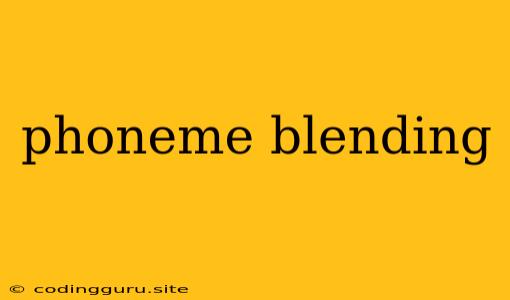Phoneme Blending: Unlocking the Magic of Speech
Phoneme blending is a fundamental skill in early literacy development. It's the ability to combine individual sounds (phonemes) together to form a word. Imagine building a word like a Lego structure, each block representing a sound. Phoneme blending is the process of putting those blocks together to create the complete word.
But why is phoneme blending so important? It's the bridge between recognizing individual sounds and understanding spoken words. Think of it as the key that unlocks the door to reading and spelling.
How Does Phoneme Blending Work?
Let's take the word "cat" as an example:
-
Break it down: We start by separating the word "cat" into its individual sounds: /k/ /æ/ /t/.
-
Say it slowly: We then say each sound out loud, emphasizing each one: "k...a...t".
-
Blend it together: Finally, we blend the sounds together quickly to form the word "cat".
Why is Phoneme Blending Important?
1. Foundational for Reading: Phoneme blending allows children to decode written words by sounding out each letter and blending the sounds together.
2. Boosting Spelling Skills: Understanding phoneme blending helps children spell words by breaking them down into their individual sounds.
3. Improving Listening Comprehension: Phoneme blending helps children attend to individual sounds in spoken words, improving their ability to understand what they hear.
Tips for Teaching Phoneme Blending
1. Start Small: Begin with simple, one-syllable words like "cat", "dog", "sun", and "hat".
2. Use Visual Aids: Utilize pictures, manipulatives, or even your fingers to represent each sound in the word.
3. Practice Regularly: Consistent practice is key. Incorporate phoneme blending activities into daily routines, such as during playtime or mealtime.
4. Make it Fun: Use games, songs, and stories to make phoneme blending an engaging experience.
5. Encourage Repetition: Repeating the sounds multiple times helps children develop a strong auditory memory.
Phoneme Blending Activities
Here are some engaging activities you can use to practice phoneme blending:
1. Picture Blending: Show a picture of an object and say the sounds of the word slowly. For example, show a picture of a cat and say "c...a...t". Ask the child to blend the sounds together and say the word "cat".
2. Sound Box: Use a box with separate compartments for each sound in a word. Have the child place a small object in each compartment representing a sound. Then, have them take out the objects one at a time and blend the sounds together.
3. Elkonin Boxes: This method uses boxes to represent each sound in a word. The child places a marker in each box as they hear the sounds. Then, they blend the sounds together to say the word.
4. Sound Puzzles: Create puzzles with individual letters or pictures that represent sounds. Have the child put the pieces together to form a word.
5. Phoneme Blending Cards: Make flashcards with individual sounds and words. Have the child blend the sounds together to form the word.
Conclusion
Phoneme blending is a crucial stepping stone for early literacy development. By mastering this skill, children develop a strong foundation for reading, spelling, and listening comprehension. Through consistent practice, fun activities, and engaging techniques, children can unlock the magic of speech and embark on a journey of lifelong learning.
